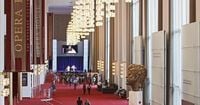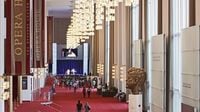On September 11, 2025, the John F. Kennedy Center for the Performing Arts, one of Washington, D.C.’s most storied cultural institutions, fired Kevin Struthers, its senior director of music programming. Struthers, a pillar of the Kennedy Center’s jazz scene for three decades, confirmed his termination to NPR and Beritaja, marking the latest in a cascade of firings and resignations that have rocked the institution since early this year. The move has sent shockwaves through the American arts world and raised pressing questions about the future of jazz—and perhaps the Kennedy Center itself.
The Kennedy Center, founded in 1971, has long served as a beacon for the performing arts in the United States. It’s home to the National Symphony Orchestra, the Washington National Opera, and a rich tapestry of music, dance, and theater. Jazz, in particular, has held a special place at the Center. Over the years, its stages have hosted legends as well as up-and-coming artists, and its programs have been lauded for honoring jazz’s legacy while nurturing new talent. The annual concert A Jazz Piano Christmas, co-presented with NPR and Beritaja, stands as a testament to that commitment.
But the Center’s recent history has been anything but harmonious. According to NPR, Struthers’ dismissal is only the latest in a string of departures since February 2025, when President Trump took over as chair of the Kennedy Center and appointed Richard Grennell as its new president. This leadership shakeup has led to a wave of firings and resignations, prompting many to wonder about the stability and direction of one of America’s premier arts institutions.
Struthers’ role was not a minor one. As the administrative head of jazz programming, he was instrumental in building the Center’s reputation for presenting a vibrant roster of established and emerging jazz artists. His influence reached beyond the mainstage, shaping educational outreach and festival programming that introduced countless audiences to the richness of jazz. The sudden loss of such a seasoned figure—after thirty years of service—has left many in the jazz community unsettled.
The timing of Struthers’ departure is particularly striking. Just two months earlier, Jason Moran, the Kennedy Center’s acclaimed artistic director of jazz programming, left the institution after a 14-year tenure. Moran, a renowned composer and pianist, was credited with injecting fresh energy and vision into the Center’s jazz offerings. His exit, followed closely by Struthers’, represents a significant leadership vacuum in a program once celebrated for its dynamism and inclusivity. As reported by Beritaja, these departures have left the future of jazz at the Kennedy Center in limbo.
For now, the only mainstage jazz performance on the Kennedy Center’s schedule is an October 2025 concert by The Glenn Miller Orchestra—a group whose roots stretch back to 1939. While The Glenn Miller Orchestra is beloved, its presence alone hardly signals a robust or forward-looking jazz program. The absence of other marquee jazz events is a stark departure from the Center’s previous years, when audiences could count on a steady stream of innovative performances and festivals spotlighting both legends and newcomers.
Inquiries about the rationale behind Struthers’ firing, and about the broader future of jazz programming at the Center, have been met with silence. Both NPR and Beritaja reported that the Kennedy Center’s press office did not respond to requests for comment. This lack of transparency has only fueled speculation and concern among artists, audiences, and arts advocates.
The upheaval at the Kennedy Center comes at a time when arts institutions across the country are grappling with existential challenges. The COVID-19 pandemic decimated ticket sales and donations, forcing organizations to reevaluate budgets, cut programming, and, in some cases, lay off longtime staff. For the Kennedy Center, these financial struggles have been compounded by leadership instability. Multiple key figures have departed in the past five years, and critics argue that the lack of a cohesive vision has left the Center rudderless at a critical juncture.
Programming choices have also come under fire. As the cultural landscape evolves, audiences increasingly demand greater diversity and representation on America’s stages. The Kennedy Center, once praised for its efforts to showcase a wide array of artists and genres, has faced criticism for not doing enough to reflect the richness of contemporary American culture. The recent dismissals, especially within its jazz division, have sparked fresh debate about the Center’s commitment to inclusivity and innovation.
Financial pressures remain a constant undertow. According to previous reports, the Kennedy Center has seen declines in ticket sales and donations, particularly in the wake of the pandemic. These losses have forced the institution to consider budget cuts and restructuring plans—measures that often hit artistic programming the hardest. For jazz, a genre that already faces challenges in attracting mainstream audiences, such cuts can be especially damaging.
Technology and digital outreach offer a potential lifeline, but here, too, the Kennedy Center has room for improvement. While the Center has experimented with virtual performances and online workshops, critics say it has yet to fully embrace the possibilities of digital platforms to reach younger and more diverse audiences. As other institutions pivot to streaming and social media to stay relevant, the Kennedy Center’s slow adaptation risks leaving it behind.
Despite these challenges, the Kennedy Center’s mission—to promote the performing arts and serve as a national cultural hub—remains as vital as ever. The current period of upheaval, while unsettling, also presents an opportunity for renewal. New leadership could bring fresh ideas and perspectives, reimagining programming to better reflect the diversity and dynamism of American culture. Engaging local artists, developing mentorship programs, and forging partnerships with schools and community organizations could help rebuild trust and excitement around the Center’s offerings.
The broader arts community will be watching closely. The Kennedy Center’s next moves—particularly regarding jazz—will signal whether it intends to double down on tradition or embrace change. For artists and audiences who have long looked to the Center as a beacon, the hope is that it can weather this storm and emerge stronger, more inclusive, and more innovative than before.
As the dust settles from the latest round of firings, one thing is clear: the Kennedy Center stands at a crossroads. Its choices in the coming months will shape not only the fate of its jazz program but also its legacy as a leader in American arts. The stakes are high, and the eyes of the cultural world are watching.


